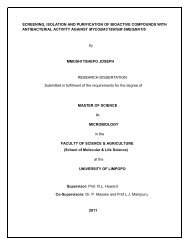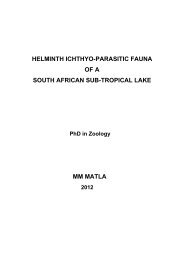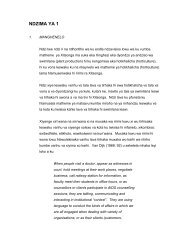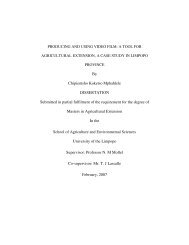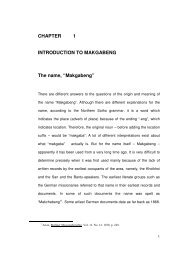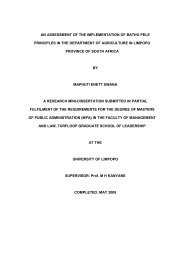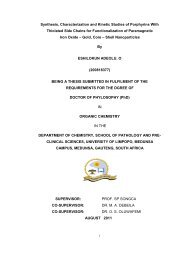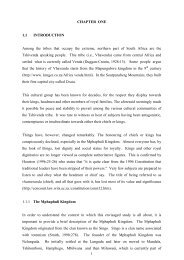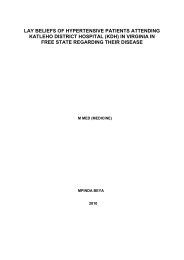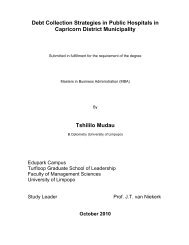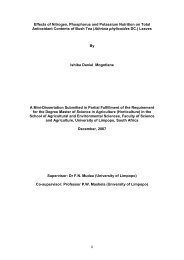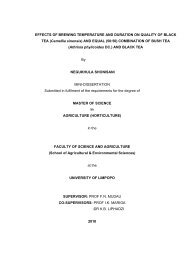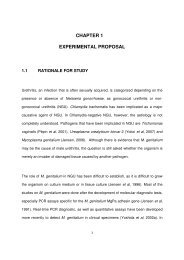Hlahla LN Mini-Dissertation.pdf - University of Limpopo Institutional ...
Hlahla LN Mini-Dissertation.pdf - University of Limpopo Institutional ...
Hlahla LN Mini-Dissertation.pdf - University of Limpopo Institutional ...
You also want an ePaper? Increase the reach of your titles
YUMPU automatically turns print PDFs into web optimized ePapers that Google loves.
The high level <strong>of</strong> polyphenols in bush tea will give advanced health benefits as it is<br />
associated with prevention <strong>of</strong> heart diseases. Moreover, the slight astringent and bitter<br />
taste associated with good teas will also be attained due to high polyphenol content<br />
present in bush tea. According to Toit and Joubert (1999), colour development in<br />
honeybush tea increased with increasing fermentation temperature while the water<br />
soluble solid and polyphenol contents decreased over the fermentation period.<br />
They also reported that fermentation at 70 o C for 60 hours and 90 o C for 36 hours<br />
produced the best flavoured tea. Similar results were reported by Weil (2002) that<br />
black tea leaves undergo a process <strong>of</strong> fermentation/oxidation that changes the<br />
colour and flavour and reduces the content <strong>of</strong> polyphenols. These results suggest<br />
that desirable colour and flavour in bush tea could be produced at 42°C as it has<br />
the least polyphenol content. However, the results from this study suggest that<br />
bush tea fermented at 34 to 38°C for 30 minutes may produce tea with impartial<br />
colour, flavour and polyphenols. Elizabeth and Ockert (1997) reported that the<br />
quality <strong>of</strong> rooibos tea improved with increasing fermentation temperature (30-42 o C)<br />
whereas quality decreased with increasing drying temperature (40-70 o C).<br />
Tannins: Tannin content at 38 and 42 o C were significantly reduced compared to 24,<br />
30 and 34 o C. Thus, bush tea leaves contain much tannin content when partially<br />
fermented at temperatures between 24 and 34 o C. This signifies that increasing<br />
fermentation temperature will certainly decrease the tannin content <strong>of</strong> bush tea. As a<br />
result, to produce tea with bitter taste and astringent flavor (tannin distinctiveness),<br />
fermentation temperatures below 34 o C should be used in bush tea. Bush tea leaves<br />
fermented at room temperature (24 o C) showed high tannin content as compared to<br />
other treatments and this will give positive health benefits effect as they eliminate bad<br />
bacteria in the mouth and impede development <strong>of</strong> dental cavities. These results<br />
suggest that when tea is fermented for 30 minutes, the temperature range between<br />
24-34 o C produces the highest level <strong>of</strong> tannin content. Furthermore, the low level <strong>of</strong><br />
tannin in bush tea fermented at 38 and 42 o C (0.3 mg/100 g) for 30 minutes will<br />
give advantage to people with digestive problems who have difficulty with tannin-<br />
rich beverages. According to Chakraverty (2003), fermentation temperatures in<br />
14



